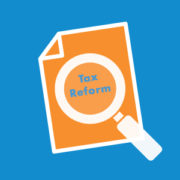Six Things Small Businesses Need to Know about the New Tax Law
The first major legislative victory on behalf of President Trump and the largest tax reform package in over 30 years, the Tax Cuts and Jobs Act was finalized by Legislators on December 20, 2017 and was signed into law just days later.
Today, we’d like to explore six important details of the new tax plan, discussing how they will impact small and medium businesses in 2018 and beyond. This is by no means comprehensive, and we would be more than happy to discuss fine intricacies with you as needed, but let this be a starting point as you read the entire text and its proposed changes to the tax code.
Corporate Tax Reduction
If you’ve only heard one thing about the new tax bill, it was probably this: The corporate tax rate in the United States has been reduced from a progressive rate reaching 35% for most corporations to a much more competitive 21 percent. The United States has long had one of the highest corporate tax rates in the world: The Federal Government levied 35% of a corporation’s earnings—before state taxes.
In total, the average corporation paid 38.91% of its income to Federal and State Governments, comparable to 35% rates levied by Sudan, Democratic Republic of Congo, and Chad.
Additionally, the combined Federal and State Corporate tax rates were 59% higher than Denmark, 77% higher than Sweden, and 211% higher than the business-friendly Ireland.
The reduction in corporate tax rates will not only encourage more investment in people (who also will see more of their paychecks), it will reduce a company’s motive for offshoring, create more opportunity for research and development (which also gets a change), and positions the United States for growth.
What This Means for Small Businesses
For incorporated small businesses, who are often the target of feel good bills designed for campaign emails, this is a lifesaver, and something that will immediately start saving them money. Under the previous administration, a business could be penalized for hiring its 50th full time employee, offering to reimburse employee health insurance premiums, or growing too fast, but now, small business owners can reinvest their earnings into the business, offer better benefits, or position themselves for growth.
Pass-Through Deduction for Business Income
As a small business, if you’re not a C-Corp, it’s likely you’ve incorporated as an S-Corp, a partnership, or something of the like in order to reduce your personal liability in the event of a lawsuit. For many businesses, this is a much more affordable alternative to the double taxation that occurs under a C-Corp.
Under the new law, pass-through businesses (owners, partners and shareholders of S-corporations, LLCs and partnerships) receive a 20% deduction. It’s not that simple, of course, and will be tackled as you start to look at quarterly taxes or speak with your bookkeeper. For a look at all of the nuances, please view the Forbes article explaining Section 199A.
What This Means for Small Businesses
Small business owners and partners have put blood, sweat and tears into their business and will now be able to keep more of their own money. As the owner is often the person who gets paid last, who has often forgone a paycheck of his own to make payroll for the month, this is a welcome change, and could reward small business owners in multiple ways.
It also could add complexity for small businesses.
100% Expensing of Certain Assets (Section 168(k))
Another benefit for small businesses is the continuation and expansion of Section 179 expensing. Perhaps the most impactful change in all of the Tax Cuts and Jobs Act was to provide for 100% expensing of certain assets. Businesses love it. Economists love it. And any tax preparer who has had to navigate the interplay between the seemingly endless depreciation incentives in order to simply calculate the deduction for a given year really loves it.
Immediate Expensing (Section 179)
The law allows full expensing of short-lived capital investments — rather than requiring them to be depreciated over time – for five years, but phase the change out by 20 percentage points per year thereafter. The section 179 deduction cap doubles to $1 million, and phaseout begins after $2.5 million of equipment spending, up from $2 million.
Increase in Caps to Use Cash Accounting
A slight change for small businesses on the brink of being required to use accrual basis for tax purposes. The eligibility threshold for using cash accounting has increased from an average of $5 Million over the past three years to $25 million.
Changes to Net Operating Loss Carrybacks and Carryforwards
A net operating loss (NOL) is a loss taken in a period where a company’s allowable tax deductions are greater than its taxable income. The law scraps net operating loss carrybacks and caps carryforwards at 90% of taxable income, falling to 80% after 2022.
More Changes Ahead in 2018
While tax reform is now a reality, what could be next? From new infrastructure spending to necessary changes to tackle the budget deficit, tax reform is only one of the many legislative changes that could be on the horizon. As America forges ahead into 2018, we want to help you grow alongside the economy. At rinehimerbaker, we are experts in the field of outsourced accounting, accounting technology, and more, and want to help you. From tax advice to software implementations, we have the people and tools to help you. Get in contact with us to learn more.





Leave a Reply
Want to join the discussion?Feel free to contribute!